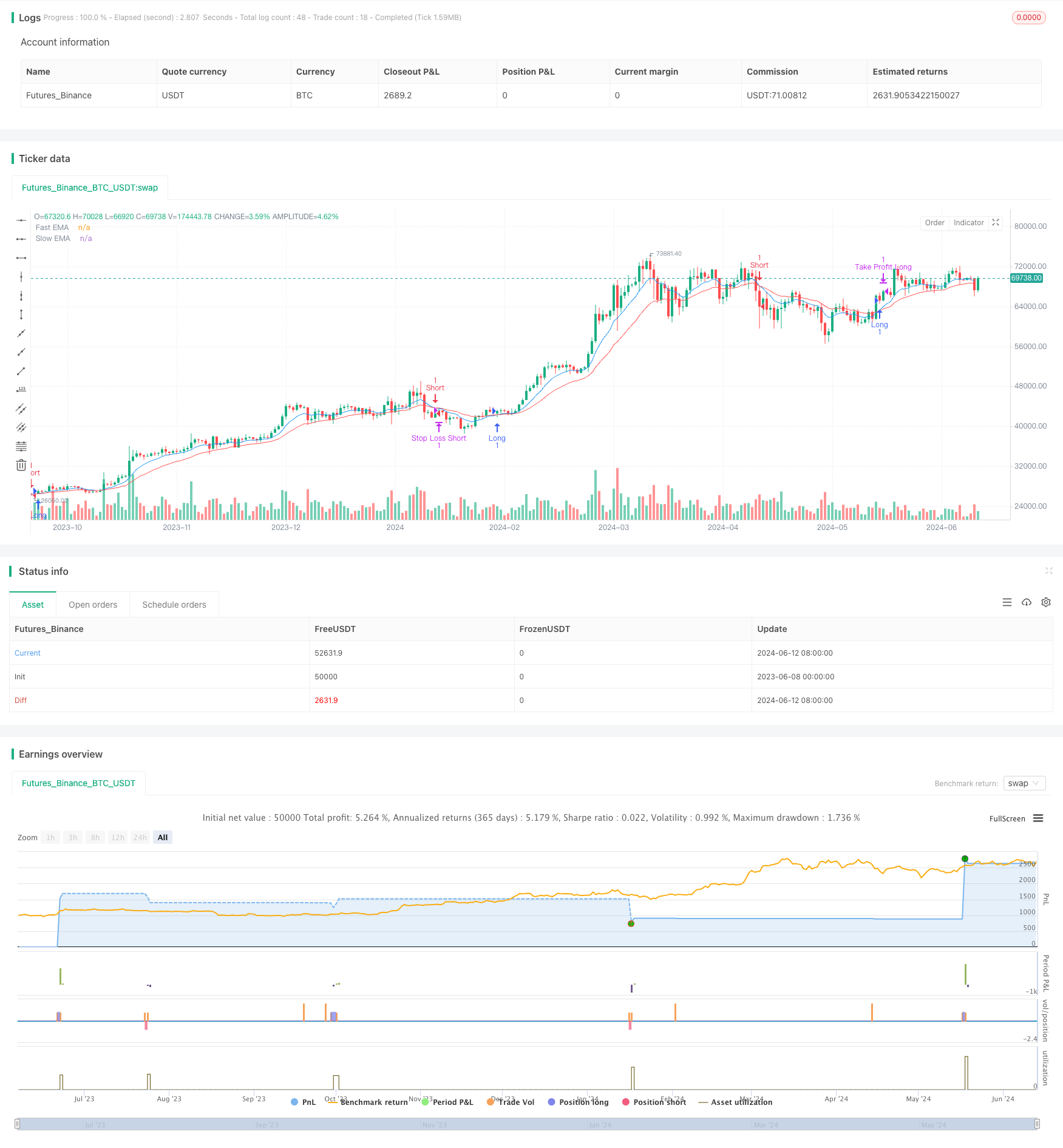
Overview
This strategy uses the crossover signals of two exponential moving averages (EMAs) with different periods to capture the short-term momentum of the market. It opens a long position when the fast EMA crosses above the slow EMA from below, and opens a short position when the fast EMA crosses below the slow EMA from above. Stop-loss and take-profit levels are set to control risk and lock in profits. This is a simple and classic short-term trading strategy based on the momentum effect.
Strategy Principles
- Calculate two EMAs with different periods, with default parameters of 9 and 21 periods, which can be adjusted based on market characteristics and personal preferences.
- When the fast EMA crosses above the slow EMA from below, it generates a long signal and opens a long position.
- When the fast EMA crosses below the slow EMA from above, it generates a short signal and opens a short position.
- When opening a position, set the corresponding stop-loss and take-profit prices based on the entry price and risk preference.
- When the price reaches the take-profit or stop-loss level, close the current position and wait for the next trading signal to appear.
Strategy Advantages
- Simple and easy to use: The strategy logic is clear and can be implemented with just two EMAs of different periods, which is very simple and easy to understand, suitable for beginners to quickly get started.
- Suitable for short-term trading: EMAs are sensitive to price changes and can quickly react to short-term market trends, making them very suitable for short-term traders to capture short-term fluctuation opportunities in the market.
- Trend following: EMA is a lagging indicator, but also a very good trend-following indicator. The EMA crossover strategy can help traders trade in line with the trend direction.
- Controllable risk: The strategy sets a percentage stop-loss and take-profit, which, although the risk-reward ratio is not very high, can provide some protection and reduce the risk of account blowout when the market trend is unclear or volatility is high.
Strategy Risks
- Frequent trading: Compared to long-term strategies, this strategy will have a higher trading frequency, and there may be frequent opening and closing of positions during market fluctuations, which will significantly increase transaction costs and have a certain drag on account funds.
- Parameter optimization: The choice of EMA parameters has a great impact on the strategy performance, and the optimal parameters may become invalid due to changes in market conditions, requiring regular checking and adjustment of parameters.
- Risk-reward ratio risk: Currently, the stop-loss and take-profit settings in the sample code are fixed percentages, and the risk-reward ratio is actually not very ideal. In some market conditions, the strategy may have a higher number of consecutive losses.
- Trend shuffling: In the early stage of the market transitioning from fluctuation to trend, the strategy may experience consecutive losses due to lagging recognition of direction.
Strategy Optimization Directions
- Optimize stop-loss and take-profit: According to market volatility characteristics, choose more appropriate stop-loss and take-profit setting methods, such as using ATR, percentage trailing stop-loss, etc., to improve the strategy’s risk-reward ratio and risk-return.
- Filter out volatile market conditions: Use other technical indicators or volume-price indicators to double-confirm the EMA crossover signals, such as judging whether ADX breaks above a certain threshold before opening a position, to reduce the risk of frequent trading.
- Optimize position management: Consider gradually building positions, increasing positions when the trend is clear, and reducing positions when fluctuating, to reduce capital fluctuations.
- Combine different periods: Use a combination of multiple EMAs with different parameters to generate opening and closing signals, such as using medium and short-term EMA crossovers as entry signals and long-term EMAs as trend filters to improve the accuracy of trend recognition.
- Integrate with macroeconomic analysis: Combine the strategy with macroeconomic analysis and use the strategy only when the macro situation is clear, to improve the medium and long-term performance of the strategy.
Summary
The EMA crossover momentum scalping strategy is a simple and easy-to-use short-term trading strategy that is suitable for beginners to quickly practice and become familiar with the quantitative trading process. The strategy can capture short-term momentum effects and follow market trend directions, while setting fixed percentage stop-losses and take-profits to control risk. However, the strategy also has risks such as frequent trading, low risk-reward ratio, and lagging trend recognition. The strategy can be optimized and improved in terms of optimizing stop-loss and take-profit methods, filtering out volatile market conditions, dynamically adjusting positions, combining different periods, and integrating macroeconomic analysis, in order to improve the strategy’s risk-return and stability.
/*backtest
start: 2023-06-08 00:00:00
end: 2024-06-13 00:00:00
period: 1d
basePeriod: 1h
exchanges: [{"eid":"Futures_Binance","currency":"BTC_USDT"}]
*/
//@version=5
strategy("Scalping Strategy", overlay=true)
// Parameters
length_fast = input.int(9, title="Fast EMA Length", minval=1)
length_slow = input.int(21, title="Slow EMA Length", minval=1)
stop_loss_pct = 0.7 // Risk 0.7% of capital
take_profit_pct = 0.5 // Target 0.5% of capital
// Calculate EMAs
ema_fast = ta.ema(close, length_fast)
ema_slow = ta.ema(close, length_slow)
// Plot EMAs
plot(ema_fast, color=color.blue, title="Fast EMA")
plot(ema_slow, color=color.red, title="Slow EMA")
// Trading logic
long_condition = ta.crossover(ema_fast, ema_slow)
short_condition = ta.crossunder(ema_fast, ema_slow)
// Calculate stop loss and take profit levels
stop_loss_long = strategy.position_avg_price * (1 - stop_loss_pct / 100)
take_profit_long = strategy.position_avg_price * (1 + take_profit_pct / 100)
stop_loss_short = strategy.position_avg_price * (1 + stop_loss_pct / 100)
take_profit_short = strategy.position_avg_price * (1 - take_profit_pct / 100)
// Enter and exit trades
if (long_condition)
strategy.entry("Long", strategy.long)
if (short_condition)
strategy.entry("Short", strategy.short)
// Exit long trades
if (strategy.position_size > 0)
strategy.exit("Take Profit Long", "Long", limit=take_profit_long)
strategy.exit("Stop Loss Long", "Long", stop=stop_loss_long)
// Exit short trades
if (strategy.position_size < 0)
strategy.exit("Take Profit Short", "Short", limit=take_profit_short)
strategy.exit("Stop Loss Short", "Short", stop=stop_loss_short)